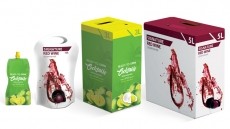Fazer begins three-year rye health drive
promoting the health benefits of rye-based products - everything
from cancer prevention to reducing the risk of coronary heart
disease. And one company at least is hoping to persuade consumers
to increase their intake by highlighting these benefits, as
Chris Jones discovered.
For the last 10 years, Fazer has been taking part in a research programme investigating the health properties of rye. The research initially focused on rye's potential capacity to reduce the risk of prostate and intestinal cancers, but a number of other potential benefits have been unearthed by the scientists over the last decade, including reducing cholesterol levels and the risk of type 2 diabetes.
But all of these discoveries will count for nothing if consumers remain unaware of the benefits of rye consumption, which is why Fazer has launched its Rye by Fazer campaign, a three-year programme of promotional events and new product launches through which the company hopes to raise awareness - and consumption - of rye-based products.
Fazer's R&D director Sampsa Haarasilta explained to BakeryandSnacks.com that rye has a number of advantages over wheat, especially when it comes to health benefits.
"In Finland, it is the whole rye grain which is processed, allowing us to retain the maximum amount of goodness from the grain in the finished product," he said. "The outer part of rye grains are rich in fibre and phytochemicals, while the kernels are also rich in fibre - much more so than wheat, whose kernels contain a lot of starch and protein as well."
Fibre content is one thing, but what of carbohydrates? According to Haarasilta, rye bread is unlikely to be impacted if the low-carb diet trend ever arrives in Finland. The carb content of rye and wheat bread is roughly the same, but the high fibre content of the former is more than likely to offset any lingering health concerns.
"Yes, rye has a similar carbohydrate content to wheat, but we would question how much of this carbohydrate was actually bioavailable - in other words, most of the carbohydrate in rye bread passes straight through the body without being absorbed. Furthermore, our research has also shown that the carbohydrates that are digested are done so slowly, and do not lead to a peak in insulin levels as other carbs might, making rye bread an ideal alternative."
Increasing consumer appeal
Finnish bread consumption is currently around 200 million kg a year, or 40kg per capita, of which some 30 per cent is rye bread and 70 per cent wheat bread, and while Fazer has set no definitive target for increasing rye bread intake as a result of the Rye by Fazer programme, it has ambitious plans to extend the range of rye-based products available on the market.
The company already has 37 different rye-based products on the market, including bread brands Reissumies, Ruispuikula, Reilu, Real and Jälkiuunileipä and crispbread brand Fazer Crisp, which together sell more than 25.000 tons per year, but most new product development over the next three years is likely to focus on products with higher added value and more consumer appeal.
This, as Haarasilta explained, is because rye is not the easiest of products to get to like. "Rye takes some getting used to, especially for consumers who eat mainly wheat-based bread products," he said. "The trick is to get consumers interested in it at an early age, then they are more likely to eat it throughout their lives. But this means making rye-based products with a taste profile which appears to younger consumers."
This explains the focus on schools - with the Bread in the Playground project and a new scheme which will see the company supply rye-based cereal bars to educational establishments throughout Finland through a link-up with a supplier of school meals there - but also means that the focus on R&D will be tighter than ever over the next three years.
"We have already been able to adapt the recipe for some rye products to cater for different tastes," Haarasilta explained. "Finnish consumers are more used to the slightly sour taste of rye bread, but we have created a sweeter tasting version for Sweden and Germany which has proved very popular."
But it is not just tweaking the recipe which will help promote increased rye consumption. The company is also looking into a number of new product developments which would push rye into new categories. Haarasilta said that, for example, the company was developing a rye-based product which would be marketed as an alternative to potato chips, taking it into the snacking sector and tapping into increasing consumer demand for healthy, portable and convenient foods.
An ethnic food?
Rye is a popular grain in much of northern Europe because of its ability to grow in poor soils where other grains, such as wheat, will not, and it has become a particular staple in Scandinavia and Germany - a factor which Haarasilta said could also help promote foods made using the grain in other countries.
"Ethnic products such as Mexican or Italian foods are very popular in Scandinavia, so I do not see why Finnish 'ethnic' foods, including products made using rye, should not be successful in other countries, especially with the combination of the clean, healthy image of Scandinavia and the health benefits of rye to promote them," he said.
The problem with increasing demand for rye, however, is that it could soon outstrip production, with rye yields traditionally much lower than those for wheat. But Haarasilta explained that importing rye from countries such as Germany and Sweden, and increasingly Poland, would not dilute the 'healthy Scandinavian rye' message.
"Even if our products are not made 100 per cent from rye grown in Scandinavia, I do not think that this would be a problem. The rye we import is almost exactly the same as that which we buy ourselves in Finland, and since we process it ourselves, we can justifiably claim that it products made from it are Scandinavian in origin."
Keeping this quality image is important, since Fazer and other producers of rye products need to increase sales to justify the significant investment in processing equipment adapted to the requirements of making rye products.
"Rye flour contains no gluten," Haarasilta explained, "which makes keeping a soft structure and volume for rye dough very difficult to achieve. The handling properties of rye dough require specific equipment, and it is a much more time-consuming process than for wheat-based products."
This, though, means that there is a relatively little production of rye bread at the artisan baker level. "To make good rye bread on a day-by-day basis is very expensive, which means that it is only those companies which can produce it in sufficient quantities [i.e. industrial bakers] which can really make rye bread profitable," Haarasilta said.













